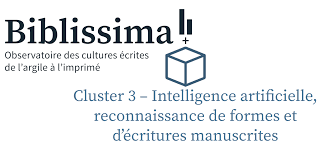|
General Biblissima+ (Observatoire des cultures écrites, de l’argile à l’imprimé), supported by the Campus Condorcet, is one of the EquipEx+ structuring facilities for research funded under the Investissements d'avenir program. It takes over from ÉquipEx Biblissima (Bibliotheca bibliothecarum novissima) and creates a multi-polar digital infrastructure for fundamental research and services dedicated to the history of the transmission of ancient texts, from the first Mesopotamian clay tablets to the first printed books, on all media and in all languages. Biblissima+ is structured around 7 areas of expertise or « clusters » organized according to the data life cycle. Cluster 3 “Artificial Intelligence for pattern and handwriting recognition”, coordinated by Dominique Stutzmann (directeur de recherche, IRHT - CNRS) and Daniel Stökl Ben Ezra (directeur d'études, EPHE-PSL, AOROC UMR 8546), focuses on the use of artificial intelligence for the recognition of forms, characters, and handwriting, enabling the study of ancient handwritten and printed books, sigillography, numismatics, and heraldry. Biblissima+ will be dealing with massive and diverse data, in terms of materials, languages, and writing systems. The cluster's work will be carried out in close collaboration with other clusters to formalize text, exploit images, read and understand text. The cluster aims to open up access to infrastructures and data and to provide users with the most powerful and up-to-date tools possible while respecting the finesse and diversity of historical research. Biblissima+ is involved in the discussion about the future of training offered to communities focused on the analysis of medieval manuscripts using artificial intelligence. In this context, this Cluster 3 day is organized as a seminar reflecting on the future of doctoral training at the European level. A seminar with key members of this community will take place throughout the day around the topic "a doctoral network for the future : M3D – Medieval Manuscripts – From Material to Digital and Back," concluding with a public roundtable at the end of the day. Biblissima+ is supported by a grant of Agence Nationale de la Recherche (Programme d’investissements d’avenir / France 2030, ANR-21-ESRE-0005). 2025 edition: the future of doctoral training (M3D - Medieval Manuscripts From Material to Digital) The European Middle Ages are often misrepresented or misused, both in scholarship and in society/media. The increasing availability of digital data and images of Medieval Manuscripts, our main source for information about the Middle Ages, presents an opportunity to fundamentally change this narrative and exponentially expand our knowledge. However, there is a challenge: scholarship lacks the know-how, both technical and conceptual, to deal with this mass of new data and fully realize its potential. Both creation of and research on these data happens in a fragmented way, without clear direction or conceptual and methodological standardization. To overcome this problem, we need to forge stable and sustainable interdisciplinary bonds, create a new paradigm for the use of medieval manuscripts as historical sources and train a new generation of scholars to use the data, apply the technologies, and ask new questions. A doctoral network is the perfect environment to achieve this. With this network, we can achieve a new paradigm for the study and representation of the Middle Ages, centered on medieval manuscripts, our richest and currently most underexplored source of data for the period.
Final round table "Medieval Manuscripts From Material to Digital: the Future of Doctoral Training at the Crossroads of Manuscript Studies and AI" The conclusive round table discusses "Medieval Manuscripts From Material to Digital: the Future of Doctoral Training in Europe". Attendance is free, but registration is required (follow this link). The round table will be held in English. Along with disciplinary contents, the participants will discuss organizing a doctoral training promoting transferable and intersectorial skills and inclusivity with a top-quality supervision. Announced participants are: Shari Boodts Professor at the Radboud University in Nijmegen. Lucie Doležalová Professor at Univerzita Karlova (Charles University) in Prague. Mark Faulkner Professor at Trinity College in Dublin. Franz Fischer Professor at the Università Ca' Foscari in Venice. Alicia Fornés Senior researcher à l'Universitat Autònoma de Barcelone (UAB). Christopher Kermorvant CEO of TEKLIA. Mike Kestemont Professor at the university of Antwerp. Peter Stokes Professor at EPHE-PSL. Dominique Stutzmann Director of research at IRHT - CNRS. Georg Vogeler Professor at the Karl-Franzens-Universität in Graz. |


